Frosties and Corn Flakes are pretty similar-looking cereals, but it’s no secret that Frosties are covered with a sugary coating making Corn Flakes feel like the more sensible choice.
But is this really the case, and is there any difference between the two when it comes to nutrition?
In this article, I’ll be comparing Kellogg’s brand Frosties and Corn Flakes against each other to find out if one is better than the other in various categories, from nutrition to cost.
For information, this article relates to UK brand information; if you’re in the USA, click here to see the USA version comparing Frosted Flakes and Corn Flakes.
Also in This Article
In a hurry, or looking for something specific? Use the links below to jump to the relevant section:
- Ingredients Comparison
- Frosties Vs. Corn Flakes Nutritional Comparison:
- Best for Calorie Content
- Best for Carbs & Sugar Content
- Best for Protein Content
- Best for Fat Content
- Best for Fiber Content
- Best for Sodium/Salt Content
- Best for Vitamins/Minerals
- Best for Flavor/Texture
- Best for Price
- Overall Winner
Ingredients Comparision
When you compare the ingredients of Kellogg’s Frosties against Corn Flakes Ingredients, they look the same, but what we don’t know at this stage is how much of each ingredient is used for each cereal.
Frosties and Corn Flakes are both made from maize, sugar, barley malt extract, salt, and the addition of vitamins and minerals to provide the consumer with a certain percentage of their daily value of each nutrient.
| Cereal Type | Ingredients | Added Vitamins and Minerals |
| Kellogg’s Frosties | Maize, sugar, barley malt extract, salt. | Niacin, iron, vitamin B6, riboflavin, thiamin, folic acid, vitamin D, vitamin B12. |
| Kellogg’s Corn Flakes | Maize, barley malt extract, sugar, salt. | Niacin, iron, vitamin B6, riboflavin, thiamin, folic acid, vitamin D, vitamin B12. |
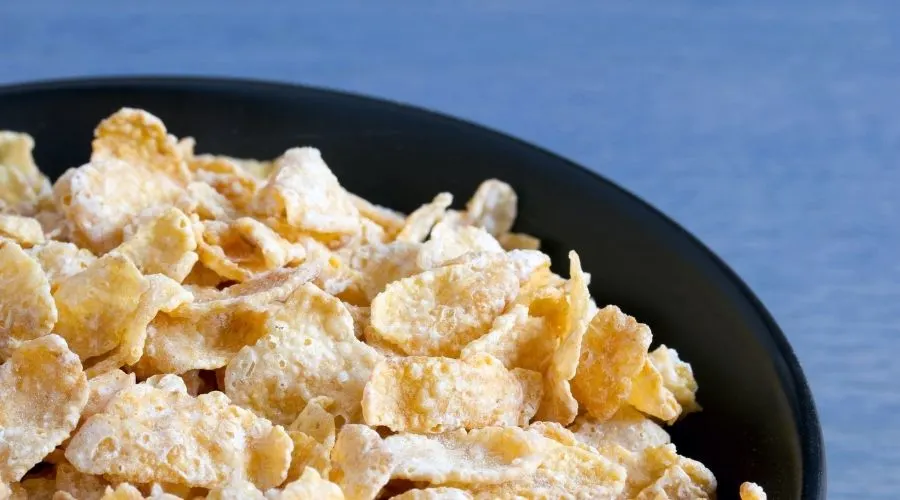
Frosties Vs. Corn Flakes Nutritional Comparison
In this nutritional comparison, I’ll be comparing Kellogg’s brand Frosties against Kellogg’s brand Corn Flakes.
Because the recommended serving size of Frosties is 35g, whereas a serving size of Corn Flakes is 30g, we need to compare on a weight-for-weight basis to get an accurate and fair comparison.
I have included a comparison per 100g weight of each product and included a serving comparison for information only.
Best for Calorie Content
Surprisingly, the cereal with the lowest calories per weight is Frosties, with 100g of Frosties containing 3kcal less per 100g than Corn Flakes.
Weight for weight, calories are very similar for each cereal, but this doesn’t necessarily mean the cereal with the lowest calories is better for you if it contains more sugar and less of the better ingredients.
| Cereal Type | Calories Per 100g | Calories Per Serving |
| Kellogg’s Frosties | 375kcal | 131kcal (Per 35g Serving) |
| Kellogg’s Corn Flakes | 378kcal | 113kcal (Per 30g Serving) |
Best for Carbohydrate Content
Both kinds of cereal will not win any awards for being low in carbohydrates, but if this is something you need to consider, then Corn Flakes are slightly lower in carbs than Frosties per weight.
| Cereal Type | Carbohydrates Per 100g | Carbohydrates Per Serving |
| Kellogg’s Frosties | 87g | 30g (Per 35g Serving) |
| Kellogg’s Corn Flakes | 84g | 25g (Per 30g Serving) |
Best for Sugar Content
The most significant difference between Frosties and Corn Flakes is the amount of sugar they contain. To get the frosted coated effect, Frosties have over four times the amount of sugar than Corn Flakes per weight.
| Cereal Type | Sugars Per 100g | Sugars Per Serving |
| Kellogg’s Frosties | 37g | 13g (Per 35g Serving) |
| Kellogg’s Corn Flakes | 8g | 2.4g (Per 30g Serving) |
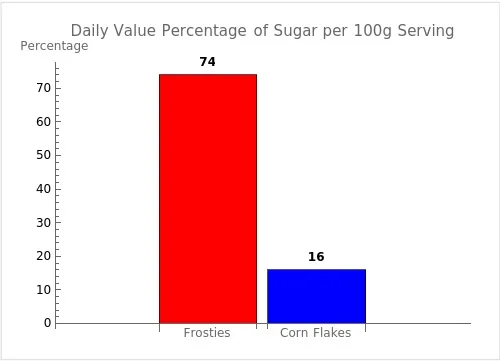
The recommended daily intake of added sugars should not exceed 10% of total daily calories, which is about 50 grams of sugar based on a 2,000 calorie diet. The graph shows that Frosties provide 74% and Corn Flakes provide 16% of the daily value for sugar per 100g serving.
Best for Protein Content
If you’re keeping track of the amount of protein in your food, then Corn Flakes are the better choice in this category because they contain slightly more protein per weight and serving.
| Cereal Type | Protein Per 100g | Protein Per Serving |
| Kellogg’s Frosties | 4.5g | 1.6g (Per 35g Serving) |
| Kellogg’s Corn Flakes | 7g | 2.1g (Per 30g Serving) |
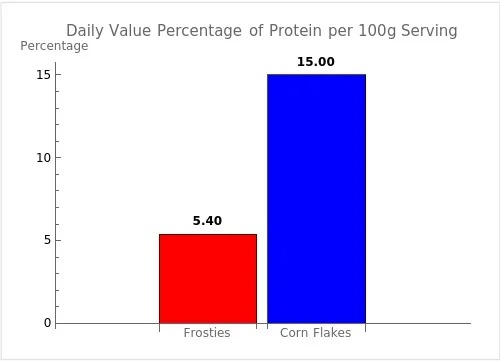
The recommended daily intake of protein is generally 50 grams for the average adult on a 2,000 calorie diet. The graph shows that Frosties provide 5.4% and Corn Flakes provide 15% of the daily value for protein per 100g serving.
Best for Fat Content
Frosties and Corn Flakes are very low in fat per serving, with Corn Flakes containing slightly more; however, it’s important to know this is a nominal amount.
| Cereal Type | Fat Per 100g | Saturated Fat per 100g |
| Kellogg’s Frosties | 0.6g | 0.1g |
| Kellogg’s Corn Flakes | 0.9g | 0.2g |
Best for Fiber Content
Neither Frosties nor Corn Flakes can be classed as high-fiber cereals compared to whole grain options such as All-Bran or Bran Flakes.
| Cereal Type | Dietary Fibre Per 100g | Dietary Fibre per Serving |
| Kellogg’s Frosties | 2g | 0.7g (Per 35g Serving) |
| Kellogg’s Corn Flakes | 3g | 0.9g (Per 30g Serving) |
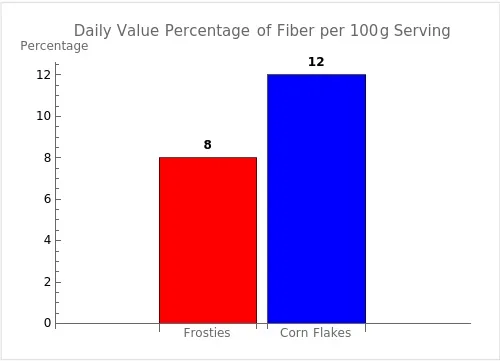
The recommended daily intake of fiber is 25 grams. The graph shows that Frosties provide 8% and Corn Flakes provide 12% of the daily value for fiber per 100g serving. The values are displayed above each bar in a clear, rounded format without fractions. Each bar is colored differently for easy comparison.
Best for Sodium/Salt Content
Corn Flakes contain slightly more salt per weight than Frosties, with Frosties containing 5% of the recommended daily amount compared to Corn Flakes, which have 6%. Neither cereals are exceptionally high in salt and wouldn’t be classed as a high-salt breakfast option.
| Cereal Type | Sodium/Salt Per 100g | Sodium/Salt per Serving |
| Kellogg’s Frosties | 0.83g | 0.29g (Per 35g Serving) |
| Kellogg’s Corn Flakes | 1.1g | 0.34g (Per 30g Serving) |
Best for Vitamins/Minerals
As you can see in the table below, Kellogg’s adds the same vitamins and minerals to Frosties and Corn Flakes, and the values are identical for each type, making them joint winners of this category.
| Vitamin/Mineral Type | Kellogg’s Frosties Value Per 100g | Kellogg’s Corn Flakes Value Per 100g |
| Vitamin D | 8.4 mcg* | 8.4mcg |
| Thiamin (Vitamin B1) | 0.91mg* | 0.91mg |
| Riboflavin (Vitamin B2) | 1.2mg | 1.2mg |
| Niacin | 13mg | 13mg |
| Vitamin B6 | 1.2mg | 1.2mg |
| Folic Acid | 166mcg | 166mcg |
| Vitamin B12 | 2.1mcg | 2.1mcg |
| Iron | 8mg | 8mg |
*mcg = microgram (1000th of a milligram) / mg = milligram (1000th of a gram)
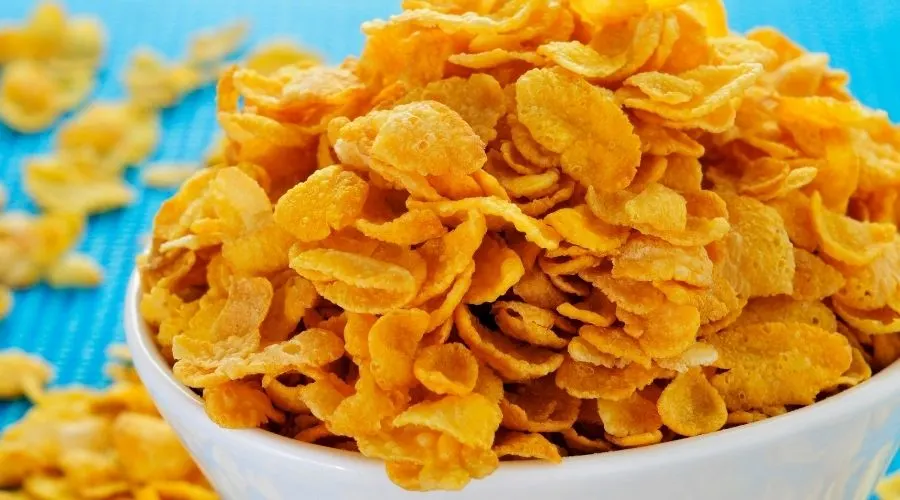
Best for Flavor/Texture
It’s difficult to judge a winner in the flavor category without a poll over a broad demographic of opinions from the general public.
To help us find an answer to the question of which is best for taste, Frosties or Corn Flakes, you can vote in the poll below to tell future readers and us which is your favorite.
Once you vote, you can see the winner of the poll so far (no personal information required).
Best for Price
At the time of writing this article (in March 2022), the average cost of a 500g box of Frosties in the UK costs £2.50-£3.00, depending on where you buy them.
The same-sized box of Kellogg’s Corn Flakes costs an average of £2.00 per pack.
Based on this information, Corn Flakes are the lower cost option in the UK compared to Frosties.
Overall Winner
The votes are now in, and we have a winner of the most categories in nutrition and cost, and the winner is – Corn Flakes!
Although they contain a few calories more, Corn Flakes have much less sugar than Frosties; they’re slightly lower in carbs and a little higher in protein and fiber.
It’s important to note that there are healthier cereals than the two compared in this article, but you can use the information in this comparison to decide which is best for you and your diet.
| Comparison Category | Winner (Frosties or Corn Flakes) |
| Best for Calorie Content | Frosties |
| Best for Carbohydrate Content | Corn Flakes |
| Best for Sugar Content | Corn Flakes |
| Best for Protein Content | Corn Flakes |
| Best for Fat Content | Frosties |
| Best for Fiber Content | Corn Flakes |
| Best for Salt Content | Frosties |
| Best for Vitamins/Minerals | Joint Winners |
| Best for Price | Corn Flakes |
| Overall Winner | Corn Flakes |
Related Articles
I hope this article has helped you to find the information you were looking for; you might also find the following articles helpful too:
Special K Vs. Bran Flakes (Which is Best?)
All-Bran Vs. Bran Flakes (Which is Best?)
Multigrain Cheerios vs Oatmeal (Which is Better)
References Used for this Article
To ensure the nutritional information used in this article is accurate, I have used data from the manufacturer (Kellogg’s); the links below contain the source information:
